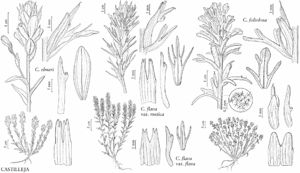Castilleja flava var. rustica
Intermount. Fl. 4: 484. 1984.
Leaves 3–5(–7)-lobed. Bracts distally pale to bright yellow or light orange, light red, or bright red; lobes short. Calyces proximally pinkish, purplish, or green, distally dull green or colored as bract lobes, 11–25 mm; abaxial and adaxial clefts (6–)7–13(–17) mm, 50–60(–95)% of calyx length, subequal, lateral 0.5–7 mm, 4–30% of calyx length; lobes linear or narrowly to broadly triangular. Corollas 15–27 mm; beak 5–8(–9.5) mm; abaxial lip (1.5–)2–3.5 mm.
Phenology: Flowering Jun–Aug.
Habitat: Mostly montane.
Elevation: 1100–2300 m.
Distribution
Idaho, Mont., Oreg.
Discussion
Variety rustica is almost always closely associated with Artemisia tridentata, which is very likely its primary host species. It is found in central Idaho, Montana, and northeastern Oregon. Reports of var. rustica from British Columbia are referred to Castilleja cervina. Apparent hybrids between this variety and C. chromosa are known from Custer County, Idaho.
Selected References
None.
